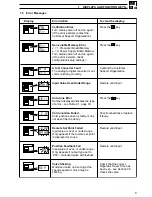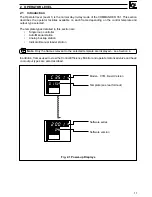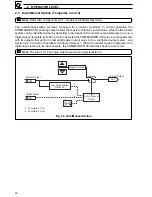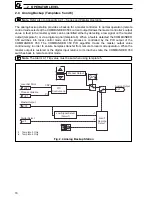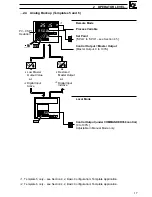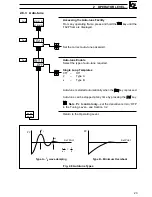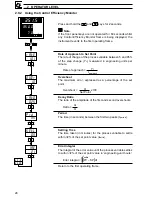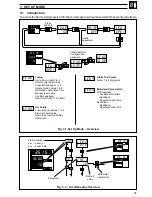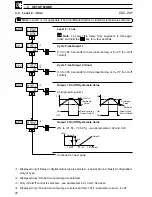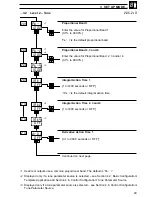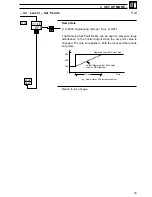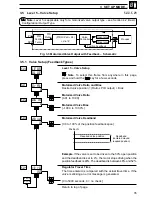
21
2.8
Auto-tune
Note. Auto-tune is not available for Auto/Manual Station or Indicator templates, or when
boundless or heat/cool control types are selected.
Information.
• Auto-tune optimizes process control by manipulating the COMMANDER 350 output and then
monitoring the process response.
• At the end of an auto-tune, the control parameters are updated automatically.
• Before starting auto-tune, the process variable must be stable.
• The COMMANDER 350 monitors the noise level of the process variable for 30 seconds and if
it is greater than 2% of the engineering range the auto-tune is aborted.
• The COMMANDER 350 selects either 'start-up' or 'at set point' tuning automatically, depending
upon the level of the process variable relative to the control set point.
2.8.1
Start-up Auto-tune
If the process variable is more than
±
10% from the set point, 'start-up' tuning is carried out.
•
'Start-up' tuning – steps the output to drive the process towards the set point. The process
response to this step change is monitored and PID parameters are calculated.
•
The output step applied = % deviation from the set point x 1.5.
•
If no errors exist, the COMMANDER 350 enters auto mode and begins to control the process
using the new PID parameters.
•
If an error occurs during the auto-tune, the COMMANDER 350 reverts to manual mode with the
control output set to the default output value. An error message is displayed in the operator
level – see Table 2.1.
2
OPERATOR LEVEL…
+2%
– 2%
t
A – Stable process before auto-tune
SPT
PV
B – Process response during auto-tune
t
PV
1/4 wave
damping
Controlling to Set Point
Auto-tune complete
SPT
>10% span
r
o
r
r
E
n
o
i
t
p
i
r
c
s
e
D
r
o
r
r
E
n
o
i
t
p
i
r
c
s
e
D
1
e
n
u
t
-
o
t
u
a
g
n
i
r
u
d
d
e
li
a
f
V
P
7
t
u
o
d
e
t
a
l
u
c
l
a
c
s
a
w
e
u
l
a
v
D
r
o
I
,
P
t
n
a
t
l
u
s
e
r
A
e
g
n
a
r
f
o
2
e
n
u
t
-
o
t
u
a
n
a
g
n
i
r
u
d
t
u
o
d
e
m
i
t
s
a
h
e
n
u
t
-
o
t
u
A
p
e
t
s
8
)
e
n
u
t
-
o
t
u
a
'
p
u
t
r
a
t
S
'
(
d
e
d
e
e
c
x
e
t
i
m
il
V
P
3
e
n
u
t
-
o
t
u
a
o
t
y
s
i
o
n
o
o
t
s
s
e
c
o
r
P
9
e
d
o
m
n
o
i
t
a
r
u
g
i
f
n
o
c
o
t
n
i
t
u
p
r
e
ll
o
r
t
n
o
C
4
e
n
u
t
-
o
t
u
a
o
t
t
s
a
f
o
o
t
s
s
e
c
o
r
P
0
1
r
e
s
u
y
b
d
e
t
a
n
i
m
r
e
t
e
n
u
t
-
o
t
u
A
5
s
r
u
o
h
2
1
x
a
m
(
e
n
u
t
-
o
t
u
a
o
t
w
o
l
s
o
o
t
s
s
e
c
o
r
P
.
)
s
e
l
c
y
c
-
f
l
a
h
n
e
e
w
t
e
b
1
1
g
n
i
r
u
d
n
o
i
t
c
e
r
i
d
g
n
o
r
w
e
h
t
n
i
g
n
i
g
n
a
h
c
s
i
V
P
t
s
e
t
p
e
t
s
6
.
g
n
e
%
5
2
>
y
b
t
n
i
o
p
t
e
s
m
o
r
f
d
e
t
a
i
v
e
d
V
P
t
s
e
t
e
s
n
o
p
s
e
r
y
c
n
e
u
q
e
r
f
g
n
i
r
u
d
n
a
p
s
Fig 2.7a Typical 'Start-up' Auto-tune Cycles
Table 2.1 Auto-tune Error Codes



